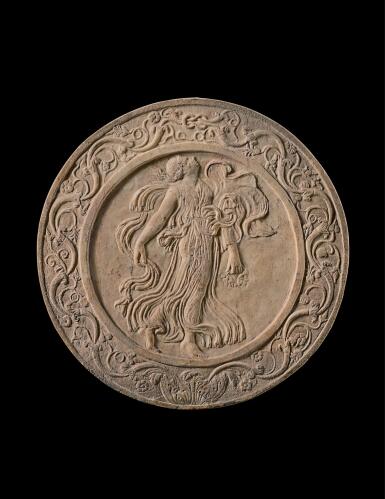Ancient Sculpture and Works of Art
Ancient Sculpture and Works of Art

Property from the Schickler-Pourtalès Collection, Château de Martinvast
A ROMAN MARBLE CIRCULAR OSCILLUM, CIRCA 1ST CENTURY B.C.
Auction Closed
July 2, 04:42 PM GMT
Estimate
150,000 - 250,000 GBP
Lot Details
Description
Property from the Schickler-Pourtalès Collection, Château de Martinvast
A ROMAN MARBLE CIRCULAR OSCILLUM, CIRCA 1ST CENTURY B.C.
carved on one side with a young satyr standing on tiptoes, holding a lagobolon in his right hand, and wearing a panther skin knotted on his right shoulder and draped over his outstretched left arm, a leaping pantheress by his side, the border decorated with twin wavy stalks emerging from a single calyx, growing leaves, flowers, and berries, and meeting on top to support a cluster of grapes, and carved on the other side with a dancing maenad raising her head in ecstasy, holding a wreath in her left hand, and wearing a chiton and billowing mantle tucked in the girdle and held in her right hand, the border decorated with twin wavy and flowering acanthus stalks rising from a single calyx and joining their tendrils on top in a Herakles knot, remains of a hole on top for suspension; small section of rim below maenad restored.
Diameter 48.7 cm.
Marchese Giampietro Campana (1808-1880), Rome, by 1851
Château de Martinvast, France, probably acquired by baron Arthur de Schickler (1828-1919)
by descent to the present owners
Published
Heinrich Brunn, "Intorno ad un disco di marmo del Museo Campana," Annali dell'Instituto di corrispondenza archeologica, vol. 23, 1851, pp. 117ff.: http://arachne.uni-koeln.de/item/buchseite/670940 (repr. in H. Bulle and H. Brunn, eds., Heinrich Brunn’s kleine Schriften, vol. 3, 1906, pp. 183ff.: https://archive.org/details/heinrichbrunnsk03bullgoog/page/n201)
Monumenti inediti pubblicati dall’Instituto di corrispondenza archeologica, vol. 5, Rome, 1849/53, pl. 29 (http://arachne.uni-koeln.de/item/buchseite/655179)
Charles Daremberg and Edmond Saglio, Dictionnaire des antiquités grecques et romaines, vol. I.2, Paris, 1887, p. 1259, fig. 1670 (https://archive.org/details/pt2dictionnaired01dare/page/1260)
Friedrich Hauser, Die neu-attischen Reliefs, Stuttgart, 1889, p. 83, no. 12 (http://arachne.uni-koeln.de/item/buchseite/1115912)
Isa Corswandt, Oscilla. Untersuchungen zu einer römischen Reliefgattung, Berlin, 1982, p. 96, no. K106, pl. 4 (with erroneous Museo Kircheriano provenance, repeated in later literature)
Lori-Ann Touchette, The Dancing Maenad Reliefs. Continuity and Change in Roman Copies, London, 1995, p. 72, no. 14, pl. 15c-d
Alberto Bacchetta, Oscilla. Rilievi sospesi di età romana, Milano, 2006, p. 459f., no. T143, pl. 23,1
Both the satyr and menad belong to types frequently copied on so-called Neo-Attic reliefs (Hauser types 22 and 31), cf. W. Fuchs, Die Vorbilder der neuattischen Reliefs (20. Ergh. JdI), 1959, pls. 18, 29c.
On June 8th, 1851, on the occasion of Johann Joachim Winckelmann's birthday, Heinrich Brunn presented the present lot to the assembled members of the Instituto di corrispondenza archeologica in Rome. His words are worth quoting:
"In order to celebrate the anniversary of Winckelmann’s birthday by exhibiting a new and charming work of art, we asked for assistance from a patron of our field, the Marquis Campana, who very often gives prestige to these events by lending some of his limitless treasures. And he did not deny our wishes, allowing us to bring here this magnificent marble disc, exhibited in front of your eyes; it is a work of art adorned with bacchanalian figures, a recurrent theme, and it might appear irrelevant to those who look only for erudition in art, however its relevance grows as we trace within it the laws of beauty which Winckelmann was the first to reveal to us."
